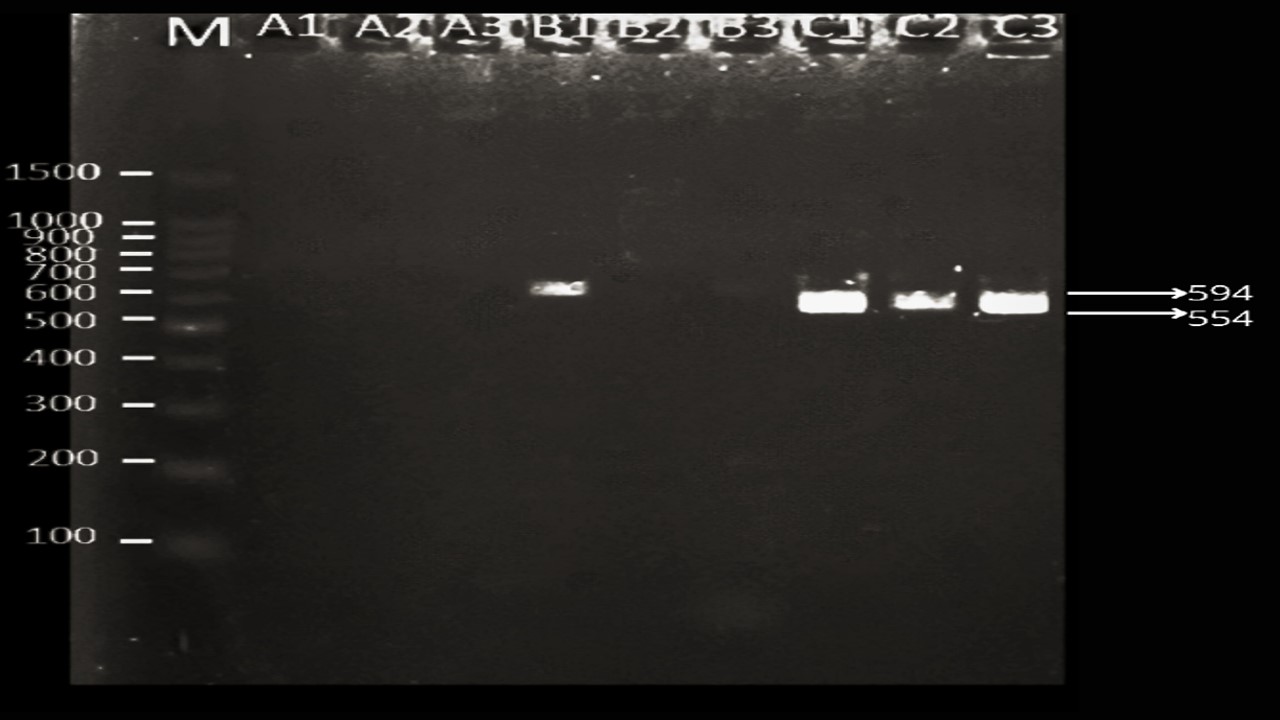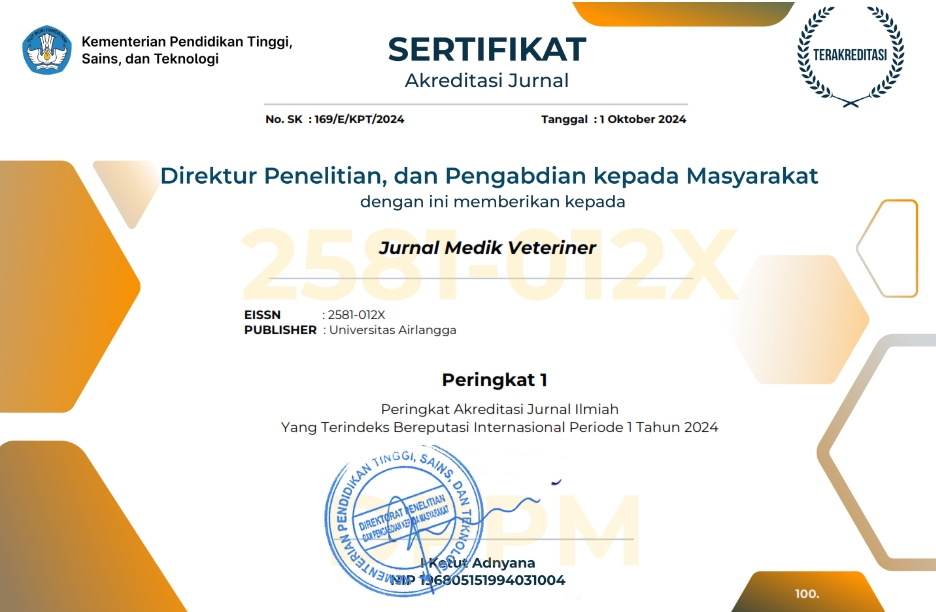Optimization of Primer Candidate Design for Toxocara cati Identification Using PCR Targeting the COX1 and ND5 Genes in Cats

Downloads
Toxocara cati is an obligate extracellular parasite within the phylum Nematoda. This species is responsible for toxocariasis, a zoonotic disease. The disease transmission occurs via infective eggs, earthworms, cockroaches, birds, and rodents that contain larvae in their tissues. In cats, infection with this parasite can lead to symptoms such as diarrhea, hypoalbuminemia, anorexia, and a distended abdomen. This research aimed to identify an optimal candidate primer design through in silico analysis using BLAST primers from the National Center for Biotechnology Information (NCBI). This study targeted the mitochondrial genes COX1 and ND5 for the molecular identification of T. cati. Using in silico methods, primer candidates were designed and evaluated based on key parameters, including primer length, melting temperature (Tm), GC content, potential for secondary structure formation, and specificity. Candidate primers were screened using the NCBI primer-BLAST tool and validated through BLAST analysis to ensure sequence specificity. The primer pair that met all the criteria for an optimal candidate primer design comprised the forward primer TCND5F (5′-ACTGCTGGCCTTGTATTGGT-3′) and the reverse primer TCND5R (5′-ACACAGAACGCCTAAACCTCA-3′), both targeting the ND5 gene region.
Almeida, M., Betancor, E., Fregel, R., Suárez, N. M., & Pestano, J. (2011). Efficient DNA extraction from hair shafts. Forensic Science International: Genetics Supplement Series, 3(1), e319–e320.
Al-Shuhaib, M. B. S., & Hashim, H. O. (2023). Mastering DNA chromatogram analysis in Sanger sequencing for reliable clinical analysis. Journal of Veterinary Diagnostic Investigation, 21(11), 1–12.
Benson, D. A., Cavanaugh, M., Clark, K., Mizrachi, I. K., Lipman, D. J., Ostell, J., & Sayers, E. W. (2013). GenBank. Nucleic Acids Research, 41(D1), D37–D42.
Budiarto, B. R., Pohan, P. U., & Desriani. (2019). Nucleic acid amplification-based HER2 molecular detection for breast cancer. Journal of Oncological Sciences, 5(1), 31–41.
Cringoli, G., Rinaldi, L., Maurelli, M. P., & Utzinger, J. (2010). FLOTAC: New multivalent techniques for qualitative and quantitative copromicroscopic diagnosis of parasites in animals and humans. Nature Protocols, 5(3), 503–515.
Despommier, D. (2003). Toxocariasis: Clinical aspects, epidemiology, medical ecology, and molecular aspects. Clinical Microbiology Reviews, 16(2), 265–272.
Dewi, D. A., Ekawasti, F., Wardhana, A. H., & Sawitri, D. H. (2019). The use of four primer sets in detecting Trypanosoma evansi in mice organs using the polymerase chain reaction (PCR) technique. Jurnal Sains dan Teknologi Peternakan, 1(1), 14–20.
El-Seify, M. A., Marey, N. M., Satour, N., Elhawary, N. M., & Sultan, K. (2021). Prevalence and molecular characterization of Toxocara cati infection in feral cats in Alexandria city, Northern Egypt. Iranian Journal of Parasitology, 16(2), 270.
Elsemore, D., Bezold, T., Geng, J., Hanna, R., Tyrrell, P., & Beall, M. (2023). Immunoassay for detection of Dipylidium caninum coproantigen in dogs and cats. Journal of Veterinary Diagnostic Investigation, 35(6), 671–678.
Englar, R. E., & Bessett, J. (2021). Fecal flotation. In Veterinary Clinical Diagnostics, Wiley. pp: 1–10.
Firdausy, L. W., Fikri, F., Wicaksono, A. P., Çalışkan, H., & Purnama, M. T. E. (2025). Prevalence of trypanosomiasis in domesticated animals in Indonesia: A systematic review and meta-analysis. Veterinary World, 18(5), 1333–1344.
Ma, G., Holland, C. V., Wang, T., Hofmann, A., Fan, C. K., & Maizels, R. M. (2018). Human toxocariasis. The Lancet Infectious Diseases, 18(1), e14–e24.
Maraghi, S., Mazhab Jafari, K., Sadjjadi, S. M., Latifi, S. M., & Zibaei, M. (2014). Study on the contamination of Abadan public parks soil with Toxocara spp. eggs. Journal of Environmental Health Science and Engineering, 12(1), 86.
Melati, R. P., Nurjanah, S., & Rahayu, W. P. (2019). Primary design of invA virulence gene for identification and sequencing of Salmonella in chicken samples. Jurnal Ilmu Produksi dan Teknologi Hasil Peternakan, 10(2), 91–97.
Murniati, S. E., & Ridwan, Y. (2016). Prevalence and risk factors of Toxocara cati infection in Bogor pet cats. Jurnal Kedokteran Hewan, 10(2), 139–142.
Nishio, T., Yoshikawa, Y., Yoshikawa, K., & Sato, S. (2021). Longer DNA exhibits greater potential for cell-free gene expression. Scientific Reports, 11(1), 1–9.
Okulewicz, A., Perec-Matysiak, A., Buńkowska, K., & Hildebrand, J. (2012). Toxocara canis, Toxocara cati and Toxascaris leonina in wild and domestic carnivores. Helminthologia, 49(1), 3–10.
Papina, N. M., Bulik, C. M., Chawner, S. J. R. A., & Micali, N. (2024). Prevalence and recurrence of pica behaviors in early childhood within the birth cohort. International Journal of Eating Disorders, 57(2), 400–409.
Pradnyaniti, D. G., & Yowani, S. (2013). In silico primer design for amplification of the rpoB gene fragment of Mycobacterium tuberculosis using polymerase chain reaction (PCR). Jurnal Farmasi Udayana, 1, 124–129.
Prakoso, S. P., Wirajana, N., & Suarsa, W. (2016). Amplification of 18S rRNA gene fragments in metagenomic DNA of honey using PCR. Indonesian Journal of Legal and Forensic Sciences, 2(3), 45–47.
Purwakasih, D. B., & Achyar, A. (2021). Primer design and in silico PCR for detection of Shigella sp. on refilled water samples. Serambi Biologi, 6(1), 1–6.
Qamar, W., Khan, M. R., & Arafah, A. (2017). Optimization of conditions to extract high-quality DNA for PCR analysis from whole blood using SDS-proteinase K method. Saudi Journal of Biological Sciences, 24(7), 1465–1469.
Rostami, A., Riahi, S. M., Holland, C. V., Taghipour, A., Fomeshi, M. K., Fakhri, Y., Omrani, V. F., Hotez, P. J., & Gasser, R. B. (2019). Global prevalence of Toxocara infection in people: A systematic review and meta-analysis. Advances in Parasitology, 109, 51–103.
Saraswati, H., Seprianto, & Wahyuni, F. D. (2019). In silico primer design for amplification of the cryIII gene from local isolates of Bacillus thuringiensis. Indonesian Journal of Biotechnology and Biodiversity, 3(1), 33–38.
Seeker, L. A., Holland, R., Underwood, S., Fairlie, J., Psifidi, A., Ilska, J. J., Bagnall, A., Whitelaw, B., Coffey, M., Banos, G., & Nussey, D. (2016). Method-specific calibration corrects for DNA extraction method effects on relative telomere length measurements by quantitative PCR. PLoS ONE, 11(10), e0164046.
Sepulveda, M. S., & Kinsella, J. M. (2013). Helminth collection and identification from wildlife. Journal of Visualized Experiments, (82), e51000.
Sihotang, M. A. E. D., Erwinda, Y. E., Suwarni, E., & Lusianti, E. (2021). Primer design and in silico analysis for amplification of the mt-Co1 gene in Norway rats (Rattus norvegicus). Eruditio: Indonesian Journal of Food and Drug Safety, 1(2), 20–29.
Subari, A., Razak, A., & Sumarmin, R. (2021). Phylogenetic analysis of Rasbora spp. based on the mitochondrial DNA COI gene in Harapan Forest. Jurnal Biologi Tropis, 21(1), 89–94.
Suparman, A. H., & Ahmad, Z. (2016). In silico PCR primer design for amplification of the COI gene in Papilio ulysses butterflies from Bacan Island. Jurnal Pendidikan Matematika dan IPA, 7(1), 14–24.
Suroiyah, F.A., Hastutiek, P., Yudhana, A., Sunarso, A., Purnama, M. T. E., & Praja, R. N. (2018). Prevalence of Toxocara cati infection on domestic cats in Banyuwangi District. Jurnal Medik Veteriner, 1(3), 99–104.
Taariwun, M. B., Ngangi, J., Mokosuli, Y., & Gedoan, S. (2021). DNA barcoding Dalugha (Cyrtosperma merkusii) in Talaud Islands and North Minahasa based on rbcL gene. Jurnal Bios Logos, 11(2), 134.
Utaminingsih, S., & Sophian, A. (2022). Analysis of purity and concentration of DNA isolation results on chondroitin samples. BiosciED: Journal of Biology Science Education, 3(2), 56–61.
Wulandari, D., Nurhayati, I., Warisman, M. A., Budiarto, B. R., & Desriani. (2017). ILE655VAL genotyping study of HER2-positive breast cancer of patients from Padang-Indonesia with high-resolution melting technique. Annales Bogorienses, 21(2), 69–75.
Yustinadewi, P. D., Yustiantara, P. S., & Narayani, I. (2018). Variant primer design techniques in pediatric patient buffy coat samples with LLA. Jurnal Metamorfosa, 5(1), 105–111.
Zhou, S. M., Wang, F., Yan, S. Y., Zhu, Z. M., Gao, X. F., & Zhao, X. L. (2023). Phylogenomics and plastome evolution of Indigofera (Fabaceae). Frontiers in Plant Science, 14, 1186598.
Copyright (c) 2025 Reza Yesica, Ni Kadek Novita, Shelly Kusumarini R, Jasni Sabri

This work is licensed under a Creative Commons Attribution-NonCommercial-ShareAlike 4.0 International License.
Authors who publish in this journal agree to the following terms:
1. The journal allows the author to hold the copyright of the article without restrictions;
2. The journal allows the author(s) to retain publishing rights without restrictions;
3. The legal formal aspect of journal publication accessibility refers to Creative Commons Attribution-NonCommercial-ShareAlike 4.0 International License (CC BY-NC-SA).






11.jpg)




















